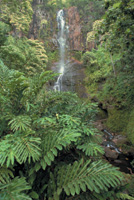Epson's Stylus Photo R800
A Superior Quality Letter-Size Photo Printer
No one should jump to the
conclusion that Epson's new Stylus Photo R800 is just a smaller
Photo 2200, although at first glance it would seem to be. It is logical
to assume that not all photographers who want to make fine digital prints
want to also make large prints. And it is equally logical to think that
if prints are smaller many of the quality attributes need to be finer.
But with their new Photo R800 Epson went even further than logic demands,
and has created an entirely new, more advanced benchmark for photographic
ink jet print quality. |
|||
From my perspective, a new
feature of the R800 that Epson chose not to promote is its use of UltraChrome
pigment inks, but with some different ink colors. Light Magenta and Light
Cyan have been replaced with Blue and Red inks. In the printing industry
this is really not all that new, as some high-end customized offset printing
has for some time employed a similar ink color strategy. One effect of
using primary red and blue ink colors, I would think, strengthens the
effect of the yellow component in the color mix that relies on just one
ink cartridge and set of print head jets. The other aspect of this new
printer's capability Epson chose not to highlight is the finer picoliter
and more jets. When combined with higher printing resolution using black
ink only, black and white photographic print results become even more
effective. |
|||
However, there is one drawback that hopefully may be corrected in the future. At the time I did the testing Epson did not offer any of the fine arts papers they sell for their larger Pro printers in letter-size, thus they can't be used with the R800. This may change though, if user demand develops for a larger selection of quality fiber-based papers for the R800. Yet, for those who want the best in print quality with a smaller than 13" wide printer, the cost of the new R800 is also considerably more affordable than the Photo 2200, at a list price of $399. Printing With The Epson
Stylus Photo R800 |
|||
Betwixt and between in my impressions
of the printer I moved on to print some commercial-type photographic illustrations
using Epson's Premium Glossy Photo Paper, which is supported by
a "Premium" custom profile and specific media selection. From
the first print made I was taken aback by a level of print image quality
in density range, saturation, and photo-realistic fidelity I have rarely
seen in my 50 years of photography. |
|||
Evaluation And Recommendation
Technical Specifications |
- Log in or register to post comments






































